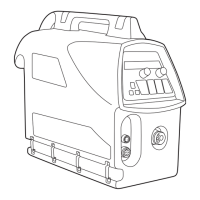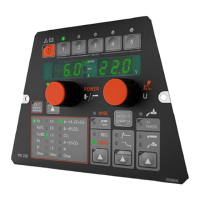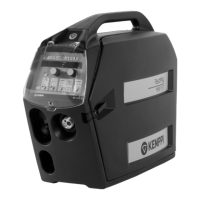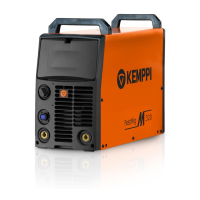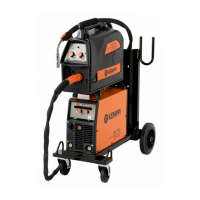Do not expose the machine to high temperatures, as this may cause damage.•
Keep intermediate and earth return cables as close to each other as possible throughout •
their length. Straighten any loops in the cables as this limits inductive eects on welding
performance. This also minimizes your exposure to harmful magnetic elds, which may,
for example, interfere with a pacemaker.
Do not wrap the welding cables around your body.•
In environments classied as dangerous, only use S-marked welding equipments with a •
safe idle voltage level. These work environments include, for example, humid, hot or small
spaces, where the user may be directly exposed to the surrounding conductive materials.
Spatter and re safety
Welding is always classied as hot work, so pay particular attention to the re safety •
regulations during welding and after it.
Remember that re can break out from sparks, even several hours after the welding work •
is completed.
Protect the environment from welding spatter. Remove combustible materials, such as •
ammable liquid from the welding vicinity, and supply the welding site with adequate re
ghting equipment.
In special welding jobs, be prepared for hazards such as re or explosion when welding •
inside enclosed work spaces, such as tanks and vessels. Ensure you have authority to work.
Never direct the sparks or cutting spray of a grinder toward the welding machine or •
ammable materials.
Beware of hot objects or spatter falling on the machine when working above. Welding in •
ammable or explosive sites is absolutely forbidden.
General electric safety
Only connect the welding machine to an earthed electric network. Note the •
recommended mains fuse size.
Do not take the welding machine inside a container, vehicle or similar work piece unless •
authorized to do so.
Do not place the welding machine on a wet surface and do not work on a wet surface. •
Do not allow the mains cable to be directly exposed to water.•
Ensure cables or welding torches are not squashed by heavy objects and that they are not •
exposed to sharp edges or a hot work piece.
Make sure that faulty and damaged welding torches are changed immediately as they •
may cause electrocution or re.
Remember that the cable, plugs and other electric devices may be installed or replaced •
only by an electrical contractor or engineer authorized to perform such operations.
Turn o the welding machine when it is not in use.•
Welding power circuit
Insulate yourself from the welding circuit by using dry and undamaged protective •
clothing.
Never touch the work piece and welding rod, welding wire, welding electrode or contact •
tip at the same time.
Do not put the welding torch or ground cable on the welding machine or other electric •
equipment.
Welding fumes
Ensure proper ventilation and avoid inhaling the fumes.•
Ensure a sucient supply of fresh air, particularly in closed spaces. You can also ensure an •
adequate supply of clean breathing air by using a ltered fresh-air mask.
Take extra precautions when working on metals or surface-treated materials containing, •
for example, lead, cadmium, zinc, mercury or beryllium.
Transportation, lifting and suspension
Never pull or lift the machine by the welding torch or other cables. Always use the lifting •
points or handles designed for that purpose.
Only use a transport unit designed for the equipment. Try to transport the machine in an •
upright position, if possible.
4
FastMig MXF65, 67 / © Kemppi Oy / 0920
I

